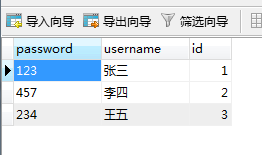这里使用的是xml配置mybatis,如喜欢注解,请待下一篇。
1 修改配置,引入json、mybatis
在pom.xml中添加mybatis-spring、mybatis、mysql-connector-java(用于mysql连接)、jackson-core、jackson-databind(用于返回对象直接映射成json),整体工程现在配置如下:
4.0.0
com.nothing
hellospringmvc
war
1.0-SNAPSHOT
hellospringmvc Maven Webapp
http://maven.apache.org
junit
junit
3.8.1
test
org.springframework
spring-core
4.2.5.RELEASE
com.fasterxml.jackson.core
jackson-core
2.7.2
com.fasterxml.jackson.core
jackson-databind
2.7.2
org.springframework
spring-context
4.2.5.RELEASE
javax.servlet.jsp
jsp-api
2.2
jstl
jstl
1.2
org.springframework
spring-web
4.2.5.RELEASE
org.springframework
spring-webmvc
4.2.5.RELEASE
org.springframework.data
spring-data-jpa
1.9.4.RELEASE
javax.servlet
servlet-api
2.5
mysql
mysql-connector-java
5.1.38
org.mybatis
mybatis
3.3.1
org.mybatis
mybatis-spring
1.2.4
org.json
json
20160212
hellospringmvc
2 上篇的myspring-servlet.xml 和web.xml 不用修改。
3 配置mybatis conf.xml文件:
需要注意的是,如下与jdbc连接的代码差不多的,这里使用xml配置,由于我使用的是mysql(如使用其他数据库请百度),url中为数据库的名称,我这里是mysql。后面两项是username 和password需自行配置。
这里需要注意路径:本文放在src/main/resources 目录下。我在这卡了很久。
userMapper.xml
insert into user_nothing(username,password) values(#{username},#{password})
这里使用xml配置sql语句。user_nothing 在mysql数据库中创建的表。三个字段,待会给出。parameterType为输入参数 id的类型int,esultType="com.nothing.Model.User"为返回值User对象。
4 User
package com.nothing.Model;
public class User {
private String username;
private String password;
private int id;
public String getUsername() {
return username;
}
public void setUsername(String username) {
this.username = username;
}
public String getPassword() {
return password;
}
public void setPassword(String password) {
this.password = password;
}
public User(String username, String password, int id) {
this.username = username;
this.password = password;
this.id = id;
}
public User(String username, String password) {
this.username = username;
this.password = password;
}
public int getId() {
return id;
}
public void setId(int id) {
this.id = id;
}
public User() {
}
}
5 UserDao
public interface IUserDao {
public User findUserById(int id); //查询
public void addUser(User user); //添加
}
UserDaoImpl 才是正真的实现类,参与数据库curd,本文只有简单的单个查询。
public class UserDaoImpl implements IUserDao{
private SqlSessionFactory sessionFactory;
private SqlSession session;
public UserDaoImpl() {
String resource = "conf.xml";
try {
Reader reader = Resources.getResourceAsReader(resource);
sessionFactory = new SqlSessionFactoryBuilder().build(reader);
session = sessionFactory.openSession();
} catch (IOException e) {
e.printStackTrace();
}
}
public User findUserById(int id) {
String statement = "userMapper.findUserById";
User user = (User)session.selectOne(statement, 1);
return user;
}
public void addUser(User user) {
String statement = "userMapper.addUser";
session.insert(statement, user);
session.commit(); //一定要记得commit
}
}
UserService中间层,负责dao与controller交互,本文较简单,可省略。
public interface IUserService {
public User findUserById(int id);
public void addUser(User user);
}
UserServiceImpl真正实现
public class UserServiceImpl implements IUserService{
private IUserDao userDao;
public UserServiceImpl() {
userDao = new UserDaoImpl();
}
public User findUserById(int id) {
return userDao.findUserById(id);
}
public void addUser(User user){
userDao.addUser(user);
}
}
6 index.jsp 利用上次的剩余价值,吼吼。
<%@ page language="java" contentType="text/html; charset=UTF-8" pageEncoding="UTF-8"%>
<%@ taglib prefix="sf" uri="http://www.springframework.org/tags/form" %>
Hello World!
用户名:
这里使用jstl标签库。
7 最后看一眼MainController,实现是用户到/hello 页面就跳到index .jsp 页面,在该页面注册后,。然后action动作toJson,返回id为2的用户
@Controller
public class MainController {
private IUserService service = new UserServiceImpl();
@RequestMapping(value = "/hello", method = RequestMethod.GET)
public String index( User user) {
return "index";
}
@RequestMapping(value ="/toJson",method=RequestMethod.POST)
@ResponseBody
public User toJson(User user){
service.addUser(user); //一起测试了
return service.findUserById(2);
}
}



